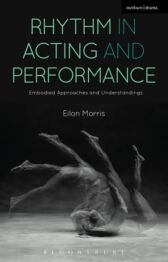Synopsis
Rhythm in Acting and Performance
Published by Methuen
Yet what is meant by this term and how it is approached and applied in this context are subjects seldom discussed in detail
Sub-titled Embodied Approaches and Understandings, Rhythm in Acting and Performance explores the meanings, mechanisms and metaphors associated with rhythm in this field, offering an overview and analysis of the ways rhythm has been, and is embodied and understood by performers, directors, educators, playwrights, designers and scholars
From the rhythmic movements and speech of actors in ancient Greece, to Stanislavski's use of Tempo-rhythm as a tool for building a character and tapping emotions, continuing through to the use of rhythm and musicality in contemporary approaches to actor training and dramaturgy, this subject finds resonance across a broad range of performance domains
In these settings, rhythm has often been identified as an effective tool for developing the coordination and conscious awareness of individual performers, ensembles and their immediate relationship to an audience
This text examines the principles and techniques underlying these processes, focusing on key approaches adopted and developed within European and American performance practices over the last century
Interviews and case studies of individual practitioners offer insight into the ways rhythm is approached and utilised within this field
Each of these sections includes practical examples as well as analytical reflections, offering a basis for comparing both the common threads and the broad differences that can be found here
Unpacking this often mystified and neglected subject, this book offers students and practitioners a wealth of informative and useful insights to aid and inspire further creative and academic explorations of rhythm within this field
TABLE OF CONTENTS
PART ONE Establishing a Pulse
Chapter 1 - What Is Rhythm? An Open Question
Chapter 2 - An Epoch of Rhythm: Now & Then
PART TWO - Stanislavski on Rhythm
Chapter 3 - Tapping Emotions: The Ins and Outs of Tempo-Rhythm
PART THREE - Structure and Spontaneity
Chapter 4 - Suzanne Bing: Music and Games in Actor Training
Chapter 5 - Vsevolod Meyerhold: Rhythm Not Metre
Chapter 6: John Britton: Smashing the Ensemble Groove
Chapter 7: Anne Bogart and Tina Landau: A Horizontal Viewpoint
PART FOUR - The Ecstatic Performer
Chapter 8: Rhythm and Altered States of Consciousness: Entrainment & Communitas
Chapter 9: Jerzy Grotowski: Seeking Pulse, Movement and Rhythm
Chapter 10: Nicolás Núñez: Becoming Present
Chapter 11: Eilon Morris: Cultivating Simultaneity
PART FIVE - A Plurality of Voices
Chapter 12 - Rhythming Words: Where, How & Why
Chapter 13 - Creating Spaces: Conversations with Judith Adams And Karen Christopher
Chapter 14 -The Poetry of the Breath - Conversations with Bruce Myers and Kate Papi
Chapter 15 -The Tune is a Framework - A Conversation with Chris Coe & Frankie Armstrong
PART SIX - Reflections Glossary of Terms Notes
 $31.99
$31.99